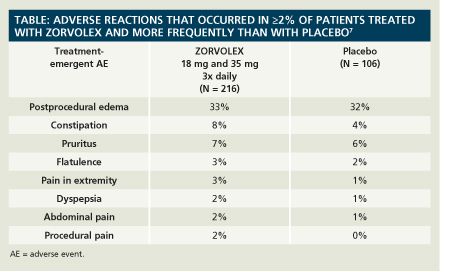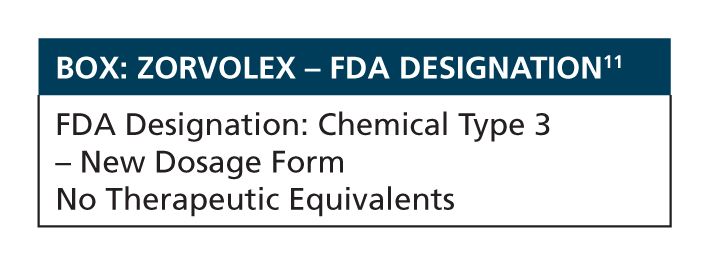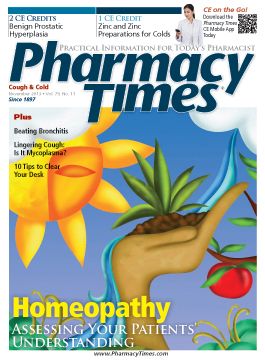Introducing ZORVOLEXâ„¢ (diclofenac), the First Lower-Dose NSAID Developed Using SoluMatrix Fine Particle Technologyâ„¢
ZORVOLEX, which is indicated for mild to moderate acute pain in adults, is the first and only NSAID developed using proprietary SoluMatrix Fine Particle Technologyâ„¢.
This article was sponsored by IROKO Pharmaceuticals, LLC
Introduction
Nonsteroidal anti-inflammatory drugs (NSAIDs) are valuable components of an effective management plan for patients with acute pain. Although beneficial, the use of NSAIDs is associated with risks, including an elevated possibility of upper gastrointestinal (GI),1 cardiovascular (CV),2 and renal events3; there is an increase in GI risk even with short-term therapy.4 Serious adverse events associated with NSAIDs are dose dependent, and studies indicate that lower doses of NSAIDs are associated with lower risk for serious upper GI, CV, and renal adverse events compared with higher NSAID doses.1-3 The FDA stipulates that all NSAIDs should be used at the lowest effective dose for the shortest duration consistent with individual patient treatment goals.5 There exists an unmet medical need for NSAID products that can inherently permit lower dosing while maintaining efficacy.
About ZORVOLEXTM
ZORVOLEX (diclofenac) is indicated for mild to moderate acute pain in adults.6 ZORVOLEX is the first and only NSAID developed using proprietary SoluMatrix Fine Particle Technology™. ZORVOLEX contains diclofenac as submicron particles that are approximately 20 times smaller than their original size.7 The reduction in particle size provides an increased surface area, leading to faster dissolution.7
In a phase 1 pharmacokinetic study, ZORVOLEX 35-mg capsules provided 23% lower overall systemic exposure (ie, the area under the curve) versus conventional diclofenac 50-mg tablets.7
Boxed Warning for All NSAIDS, Including ZORVOLEX
WARNING: RISK OF SERIOUS CARDIOVASCULAR AND GASTROINTESTINAL EVENTS
Cardiovascular Risk
- All NSAIDs may cause an increased risk of serious cardiovascular thrombotic events, myocardial infarction, and stroke, which can be fatal. This risk may increase with duration of use. Patients with cardiovascular disease or risk factors for cardiovascular disease may be at greater risk.
- ZORVOLEX is contraindicated for the treatment of perioperative pain in the setting of coronary artery bypass graft (CABG) surgery.
​Gastrointestinal Risk
- NSAIDs cause an increased risk of serious gastrointestinal adverse events including inflammation, bleeding, ulceration, and perforation of the stomach or intestines, which can be fatal. These events can occur at any time during use and without warning symptoms. Elderly patients are at greater risk for serious gastrointestinal events.
Efficacy and Tolerability of ZORVOLEX
The efficacy of ZORVOLEX has been demonstrated in clinical trials involving more than 600 patients. A phase 3 study included 428 patients who underwent elective bunionectomy with regional anesthesia and received treatments including ZORVOLEX or placebo for postsurgical pain. Eligible patients were 18 to 65 years of age and experienced moderate to severe pain, which was defined as 40 mm or more on a 100-mm visual analogue scale (VAS). Patients were randomly assigned to treatment, including ZORVOLEX (35 mg or 18 mg 3 times daily) or placebo. The use of rescue medication (hydrocodone/acetaminophen 10 mg/325 mg every 4 to 6 hours) was permitted. The primary efficacy variable was the summed differences in overall pain intensity scores over 48 hours. Results from the phase 3 trial showed that the overall summed differences in pain intensity were significantly greater for all treatments versus placebo (see Figure 1). The percentages of patients who required rescue medication were lower in all treatment groups (ZORVOLEX 35 mg [82%]; ZORVOLEX 18 mg [85%]) compared with placebo (97%).8
Adverse reactions that occurred in 2% or more of patients treated with ZORVOLEX and more frequently than with placebo are shown in the Table.7

Role of the Pharmacist
As members of the health care team, pharmacists play an integral role in pain management by making recommendations regarding therapy and also by counseling patients regarding dosage and administration, adverse events, and expected treatment outcomes. Pharmacists should be aware of ZORVOLEX as a therapeutic option for adult patients with mild to moderate acute pain. ZORVOLEX is available in lower dosage strengths (18-mg and 35-mg capsules) compared with conventional diclofenac (25-mg and 50-mg tablets).

ZORVOLEX capsules contain diclofenac acid, whereas other formulations of oral diclofenac contain the sodium or potassium salt of diclofenac (Figure 2).6,9,10 It is important to note that ZORVOLEX capsules do not result in equivalent systemic exposure as other forms of oral diclofenac. ZORVOLEX is not interchangeable with other formulations of diclofenac. There are no therapeutic equivalents to ZORVOLEX (see Box).11 Therefore, do not substitute other diclofenac products for ZORVOLEX capsules even if the milligram dose is the same.6

For more information about ZORVOLEX, visit ZORVOLEX.com.
Please click here to see full Prescribing Information for additional important safety and dosing information.
References
- Castellsague J, Riera-Guardia N, Calingaert B, et al. Individual NSAIDs and upper gastrointestinal complications: a systematic review and meta-analysis of observational studies (the SOS project). Drug Saf. 2012;35(12):1127-1146.
- McGettigan P, Henry D. Cardiovascular risk with non-steroidal anti-inflammatory drugs: systematic review of population-based controlled observational studies. PLOS Med. 2011;8(9):e1001098.
- Schneider V, Lévesque LE, Zhang B, Hutchinson T, Brophy JM. Association of selective and conventional nonsteroidal antiinflammatory drugs with acute renal failure: a population-based, nested case-control analysis. Am J Epidemiol. 2006;164(9):881-889.
- Lewis SC, Langman MJ, Laporte JR, et al. Dose-response relationships between individual nonaspirin nonsteroidal anti-inflammatory drugs (NANSAIDs) and serious upper gastrointestinal bleeding: a meta-analysis based on individual patient data. Br J Clin Pharmacol. 2002;54(3):320-326.
- Public health advisory: FDA announces important changes and additional warnings for COX-2 selective and non-selective non-steroidal anti-inflammatory drugs (NSAIDs). FDA website. www.fda.gov/Drugs/DrugSafety/PostmarketDrugSafetyInformationforPatientsandProviders/ucm150314.htm. Published April 7, 2005. Accessed October 9, 2013.
- ZORVOLEX [prescribing information]. Iroko Pharmaceuticals, LLC; Philadelphia, PA: October 2013.
- Data on file, Iroko Pharmaceuticals.
- Gibofsky A, Silberstein S, Argoff C, Daniels S, Jensen S, Young CL. Lower-dose diclofenac submicron particle capsules provide early and sustained acute patient pain relief in a phase 3 study. Postgrad Med. 2013;125(5):130-138.
- Cataflam [prescribing information]. East Hanover, NJ: Novartis Pharmaceuticals Corporation; February 2011.
- Voltaren-XR [prescribing information]. East Hanover, NJ: Novartis Pharmaceuticals Corporation; February 2011.
- Drug Details: ZORVOLEX. FDA website. www.accessdata.fda.gov/scripts/cder/drugsatfda/index.cfm. Updated October 22, 2013. Accessed October 22, 2013.
SoluMatrix Fine Particle Technology™ is a trademark of iCeutica Pty Ltd, and is licensed to Iroko for exclusive use in NSAIDs.
ZOR-0008 10/2013

